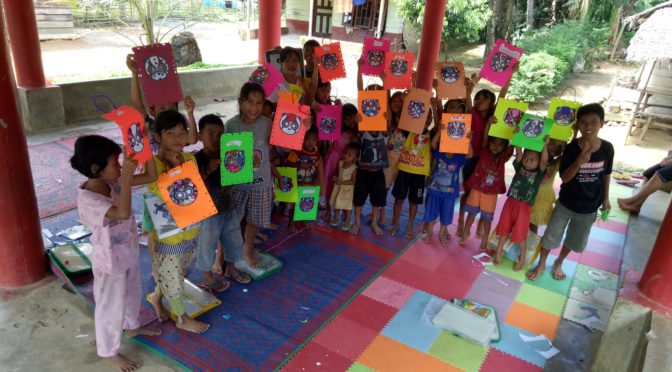HI there Slow Loris fans. I’m Andrea, a UK born conservation scientist living and working near a popular tourist destination in North Sumatra, Indonesia. In 2006 I did the Oxford Brookes MSc in Primate Conservation and have always had strong links with the LFP which as you know is based in Java…the next island along.

One of the most important aspects of my work is running a weekly Nature Club for local kids in a remote village on the borders of Gunung Leuser National Park (GLNP). We always have great fun supporting the slow loris awareness week (SLOW) and what our crazy gang of kids don’t know about slow loris isn’t worth knowing! This year in the run up to SLOW week we created our own super hero loris which had superpowers that protect the forest and help farmers.
But I want to talk about the rise of damaging “selfie tourism”…
Slow Lorises are used as photo props in the tourist trade particularly in Thailand. I have even heard of people coming across them in the wild and posing them on a branch for a cute photo.
Where I live many people visit with the expectation of seeing orangutans whilst jungle trekking…perhaps forgetting that they are critically endangered free ranging wild animals…and that nothing can be guaranteed. A major issue here is that the ex captive orangutans are very used to human presence and people feed them in order to get close and take the dreaded selfie. It continues to perplex me why visitors do not realize that it’s not ok to do this. After all…we all know that when you go to a zoo it is forbidden to feed the animals. Orangutans may look OK around humans but its abnormal to be so close and it actually causes them great stress. And as they share 97% of human DNA stress can have serious impact on their health and they can catch many human diseases.
It is crucial to note that the issue of visitors feeding wildlife and taking bad selfies is not unique to slow loris and orangutans. All over the world humans are behaving badly and there does seem to be a strong human desire to be in close contact with wildlife and to share that experience with friends and the wider social media community. e.g. whalesharks in the Philipines, kangaroos in Western Australia, sloths in South America, lemurs in Madagascar etc etc. You may recall the infamous incident where a baby dolphin died after being washed up on a Spanish beach and being passed around for selfies by tourists.
Wherever this issue occurs it is complicated and the solution is not as simple as just saying stop Pointing fingers or blaming any particular group is not helpful. I am currently working with the Gunung Leuser national park authorities on an education campaign to highlight this issue and how visitors can help.
What can we all do?
Wherever you travel inform yourself about any relevant issues before you visit and think twice about what photos you are taking especially when they involve wildlife. Are you a safe distance away? Are you following local laws/rules/guidance? Bad selfies showing close contact with wildlife encourages others to want to do the same so please only take and post photos that show you at a safe distance from wildlife. Use the #keepwildlifeaware and be #selfieaware to promote awareness of this issue.
Andrea Molyneaux

